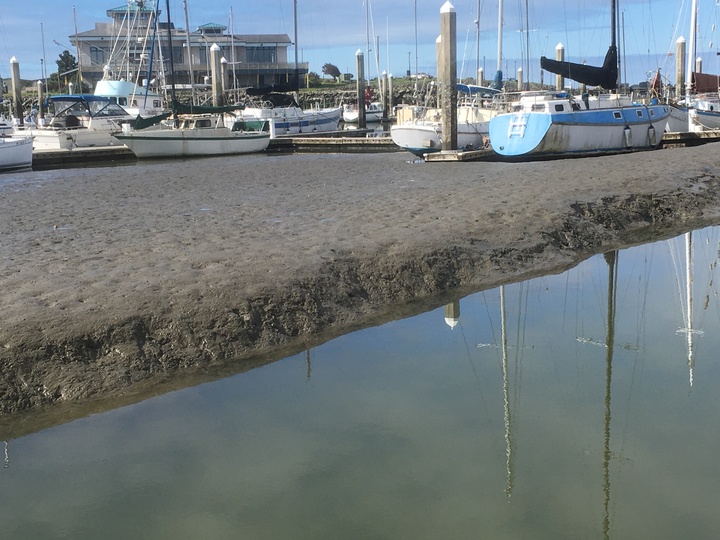
Last week, low tide rendered Eureka’s public marina a mud shelf. | Photo by Richard Hendry.
PREVIOUSLY:
- YOUR WEEK IN OCEAN: Dredge Dumping Redux! Samoa Beach Proposed for Sludge Disposal Once Again
- CITY OF EUREKA: We Gotta Dredge the Marinas, and Dumping the Spoils on the Beach is The Least Environmentally Impactful Option on the Table
Time for a Plan B.
Back in March, Eureka Parks and Recreation Director Miles Slattery outlined a plan for where to put the sediment that has accumulated along the bay floor at the Woodley Island Marina and Eureka’s public marina. Both the City of Eureka and the Humboldt Bay Harbor, Recreation and Conservation District had agreed to pursue a plan to deposit the sludgy dredge spoils on a beach on the Samoa Peninsula. That’s where such materials have been deposited for decades, including last time the marinas were dredged, back in 2007.
But yesterday, in a conference call with staff from the Harbor District and the City, officials with the Environmental Protection Agency rejected that plan in no uncertain terms.
In a phone interview today, Slattery called the decision “frustrating,” and he maintained that beach dumping would be the least environmentally impactful option. But local environmental leaders say City and Harbor District officials should have known that the EPA would reject the plan since federal regulatory agencies told them a decade ago that beach disposal would never be allowed again.
One thing everyone agrees on is that the dredging is sorely needed.
The photo above shows what Eureka’s public marina looked like late last week. Rather than floating in the water of the bay, the assorted fishing boats and pleasure sloops sat nestled in mud like figurines atop a cake. This state of affairs, which is obviously worst during low tide, has been developing for years.
“It’s gotten progressively worse,” said Richard Hendry, one of the many locals who rents a slip at the marina. Over the last couple of years he’s noticed the gradual accumulation of silt, which occasionally causes boats to run aground and become stranded for hours. “I hadn’t appreciated how bad it was until I came out the other morning,” Hendry said.
That’s when he snapped these photos. Here are a few more:
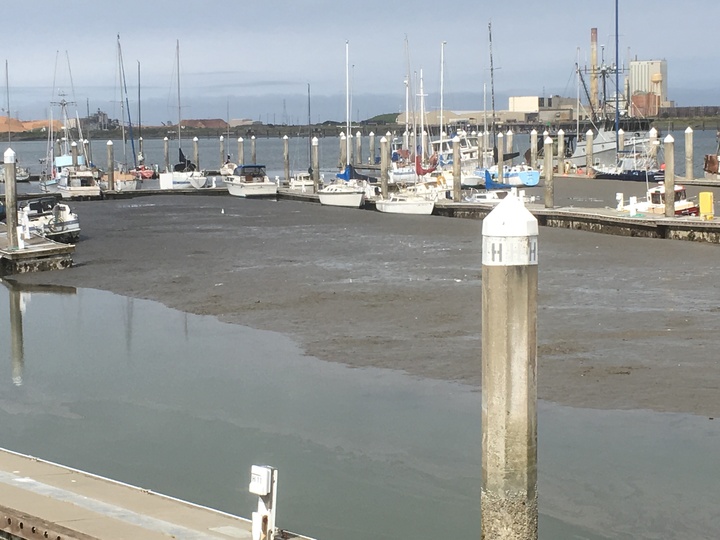

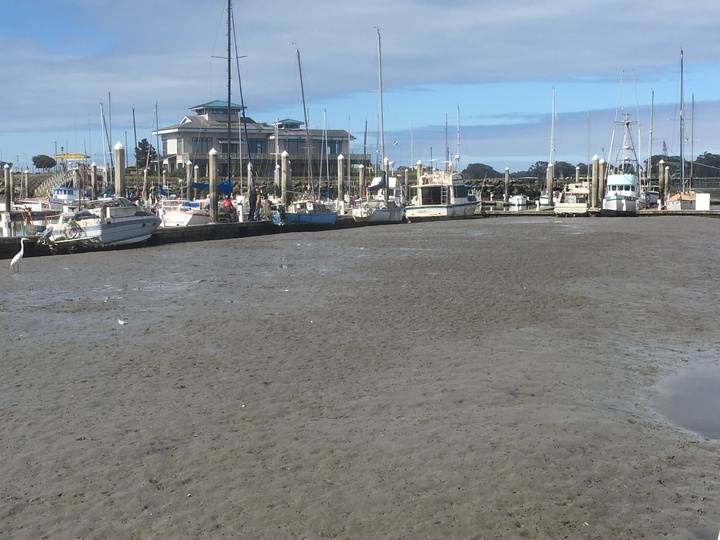
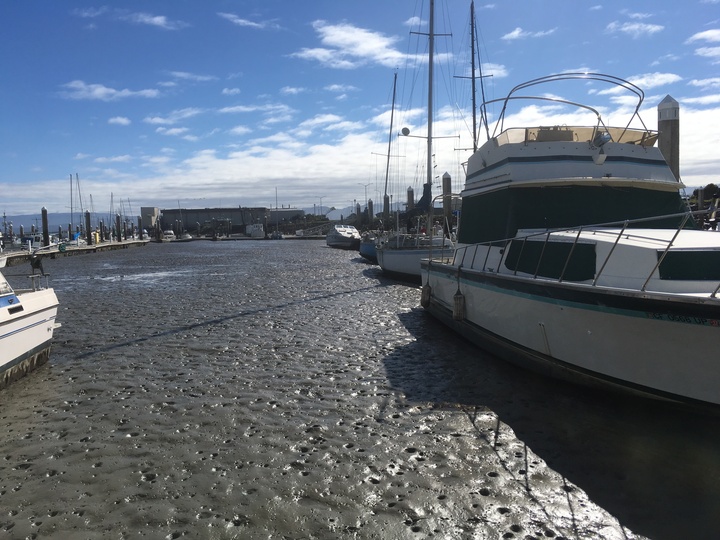
Hendry’s own boat, a San Juan 24, is now locked in the marina about 25 percent of the time due to the silt accumulation, he said. Like many others who keep boats at the marina, Hendry is annoyed that his rent has gone up and a slip fee has been implemented while sailing availability has steadily declined.
Last week, a multi-agency meeting was held in Eureka to discuss the dredging issue. Harbor Commissioner Richard Marks said most parties at the meeting were pointing to the beach as the most viable option for depositing dredge spoils. “We thought we had everybody we needed in the room, but obviously we needed the EPA,” Marks said.
The commissioner was on yesterday’s conference call with the agency and got the clear message of “no way.”
“And it was emphatic,” Marks said.
This issue dates back at least as far as 1998, when the EPA and the U.S. Army Corps of Engineers reluctantly issued a license allowing dredge spoil disposal on the beach. Environmental activists had raised concerns about the practice, largely due to the presence of dioxins in the bay mud. Meanwhile, surfers and other beach users objected to the flow of sludge that poured from a pipe and formed a small river down the beach.
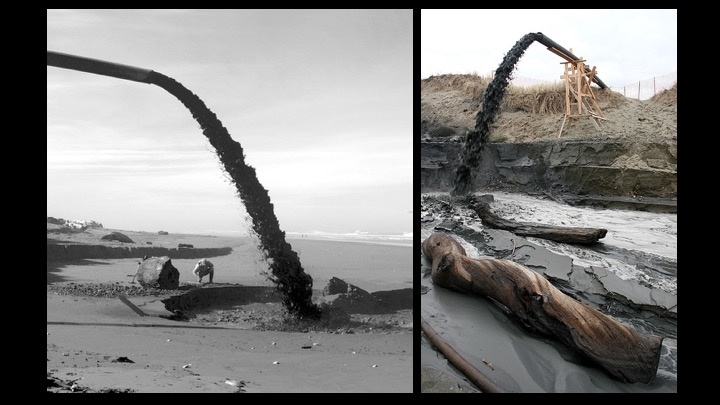
Dredge spoils being deposited on the beach in 2007. | Image courtesy the Arcata Eye.
The issue got heated again in 2006, with Humboldt Baykeeper urging the California Coastal Commission to deny permit approval for beach disposal. The commission ultimately approved the method once again, via a narrow 6-4 vote, though according to a 2006 Times-Standard story the commission also told the Harbor District and the City that it would be the last time. The local governments would need “to plan to dispose of the material somewhere else in the future.”
Such planning has fallen by the wayside.
Marks said that by the time he was elected in 2009, the dredging issue was on the back burner. The marinas’ channels had been cleared just two years prior, and with the next dredging not scheduled until the seemingly distant future of 2017 there were more pressing issues to focus on, including dredging the channels in King Salmon and, later, dealing with the toxic liquors at the former Samoa pulp mill site.
Now that the Harbor District owns its own dredge, acquired in 2014, commissioners hope to dredge the marinas more frequently than the current once-per-decade, but there has to be a place to put the spoils to make that plan possible.
Slattery said city staff was also surprised by the EPA’s stern rejection. He wasn’t aware of the previous admonition against future beach disposal. “None of us were around in 1998 when this happened,” he said. And the Coastal Commission’s subsequent approval in 2006 led staff to assume it wouldn’t be a problem this time around.
Slattery said he tried to reason with the EPA official with science-based arguments, to no avail. “I hate to say it, but it’s like talking to a brick wall,” he said.
With beach disposal no longer an option, the City and Harbor District will look at the remaining alternatives during a public meeting tonight at the Wharfinger Building, from 5:30 to 7:30 p.m.
Slattery and Marks listed a number of possible alternatives for dredge spoil disposal. There’s the Humboldt Open Ocean Dredging Site (HOODS), which was established in 1995 explicitly for disposal of ocean dredged materials from Humboldt Bay and the larger North Coast, but Slattery said it’s prohibitively expensive to get the material out that far (three miles offshore), and Marks said the Harbor District doesn’t have the right kind of equipment — namely a clamshell dredge — to make that plan feasible.
Another option that has been floated involves dredging the marina channel sediment into the bay’s flow lanes and having the Army Corps of Engineers pick it up when they dredge the shipping channels. The sediment from the channels would represent a small fraction of what the Corps removes. But to date the Army Corps has refused to approve that plan.
Another possibility is the Samoa Lagoons, a spot on the peninsula south of the Samoa bridges. It could accommodate up to 40,000 cubic yards of sediment, which is less than half of the 100,000 cubic yards slated to be removed from each of the two marinas. Plus it would likely require soil testing before permits could be issued.
Slattery argued that it would be more environmentally damaging to deposit the dredging spoils “piecemeal,” loading it into dump trucks that may require as many as 10,000 trips, with all the greenhouse gas emissions that entails.
He also takes issue with the EPA’s classification of dredge spoils as “waste.” Studies from the U.S. Dept. of Agriculture, the City and the Harbor District have shown the material to be “nutrient rich,” mostly fine sediment that should be allowed for beach replenishment, Slattery argued. “However, we’re not going to win that argument,” he acknowledged.
Jennifer Kalt, executive director of Humboldt Baykeeper, said none of this should have been a surprise.
“Clearly the staff’s not paying enough attention to this issue,” Kalt said. “We could have informed them about a lot of this stuff. … The whole thing could have been avoided.”
Kalt felt that she and others were “blindsided” by the announcement that the City and Harbor District planned to deposit the spoils on the beach once again. On a positive note, Kalt said recent sediment testing has revealed no significant dioxin or PCB contamination in the bay soils, likely the result of three major cleanup operations over the past decade.
With beach disposal now off the table, Kalt said, “We can have a much more constructive conversation about what options we can press for that aren’t objectionable to environmentalists and surfers.” She mentioned the possibility of banding together to pressure the Army Corps to accept the dredged materials in its shipping channel excavations.
And Slattery mentioned one last possible solution. Studies from the U.S. Geological Survey have shown that local salt marshes have a deficit of fine sediment material, he said, exactly the kind of stuff that will be pulled out of the bay. If the City and Harbor District were to deposit the spoils at Palco Marsh, Slattery suggested, it could replenish those materials while simultaneously combating the invasive Spartina, or European beach grass.
As with any of the other options, of course, this one would involve numerous regulatory hurdles. The Coastal Commission has designated Palco Marsh an “environmentally sensitive habitat area” (ESHA). Approval would require “a lot of studies,” Slattery said. “But based on a preliminary look we think [this option] would be beneficial.”
He and Marks said they’re hoping the public will chime in with some new ideas at tonight’s meeting. Again, it starts at 5:30 p.m. at the Wharfinger Building (map below).
CLICK TO MANAGE